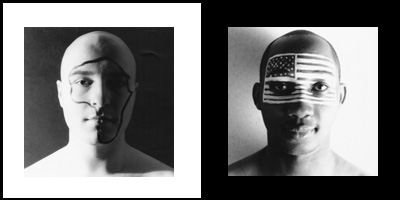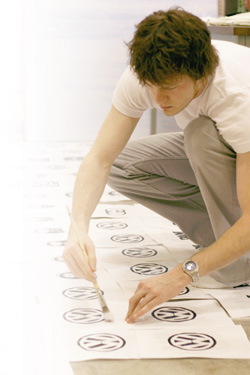|
July 12, 2004
 | |
"My art tends to contain little truths,
realizations I want people to notice."
| | Tracking down Michael Bricker is like trying to catch water between your fingers. Trying to sit him down for an interview is even tougher. In the span of a month in the second semester of his senior year, Bricker spent 10 days in Greece on an Immersion Learning trip and traveled to the universities of Virginia and Texas to narrow down his search for a graduate program in architecture. And during that same period he finished the scene design for the Wabash Theater’s production of The Illusion. Now he’s in the studio in the Randolph Deer Art Wing working feverishly to finish a series of pieces for the Senior Art Majors’ Exhibition. Yet he seems almost as interested in a suite of photos he’s put together for an advanced photography class. The five sets represent what he calls "in the gray," and depict faces of white and African American Wabash students in affected ways. The images certainly get you thinking about race at Wabash, and that’s precisely what the senior art major wants. "I guess I do tend toward controversial subjects," he says with a shrug. It’s hard to label Bricker as anything. Call him an art major and he reminds you that he’s been deeply involved in theater. Call him a scene designer and he tells you he’s had only one theater class. Ask what kind of architecture he’ll pursue after earning his master’s degree (probably from Texas) and he talks about wanting to become a production designer for theater or film. Bricker is a man of many faces and interests who possesses a keen ability to get people talking and asking questions. An intense observer, he notices things— pictures, symbols, images—others miss. And he prefers to let his design do the talking. His senior show features the work he has created this year. While the materials are simple, the message they convey—how we assert our own identity in the face of technology and consumer branding—are far from simplistic. He credits the College’s new art historian, Elizabeth Lee, for inspiring his latest work. "She completely exploded my notion of art and gave me a totally new understanding of it," the classics/philosophy double minor says. "Today the lines are blurred and the definition of art is changing; more and more it is being forced and influenced by those with power. So I returned to mass media images and focused on unpacking them. Right now I’m working with corporate logos, numbers, and faces from advertising. Through my art I ask the questions, ‘Can we function without our commercial commodities?’ ‘In the end, what is left over?’" When Bricker wanted the Wabash community to look at the war in Iraq a little differently, he made a bold statement without saying a word. As students and faculty filed into Baxter Hall one morning in spring 2003 they were greeted by 600 photocopies of the silhouette of a solitary soldier pasted on virtually every vertical surface in the building. Bricker didn’t say a word about the war, pro or con. But he got the Wabash community talking about it. The 10 images of Wabash men, racially manipulated, were similarly pasted on the inside of the glass windows in the lobby of Salter Hall in the Fine Arts Center. No complex artist’s statement; just pictures of black students with white hair and white students with dreadlocks. Once again, he got people thinking, no words necessary. "My art tends to contain subverted realities, realizations that affect the viewer long after viewing the work," he says. He’s been heavily involved in the theater at Wabash, serving as stage manager, properties master, and associate set painter on a range of productions. For The Illusion, he designed the whole set, beginning his work during the summer and following up with construction and painting in November for a show that opened in February. Technical director James Gross called Bricker’s design "completely professional in every way." "I enjoy the process of theater design as much as the product," says Bricker, who will graduate with honors as one of the Class of 2004’s commencement speakers. "I’ve never worked so hard on something in my life, and sometimes I didn’t agree with the choices involved with the production. But the give-and-take, the collaboration, was what made the process so rewarding." With a project the scope of The Illusion, he had to relinquish control. "There’s a whole crew working on the set—my design—and I’m not always there when the work is getting done," he recalls. "I can’t help but get a chill when people are bringing my drawings to life. Everyone had a stake in it—they were making choices and decisions without me. It was hard, but the results were amazing."
Bricker’s embrace of the collaborative process is enhanced in the gym. He co-founded and coached the College’s volleyball club, a team that travels almost anywhere within driving distance to play matches against more established club teams. He even hosted the first-ever intercollegiate tournament on the Wabash campus. "My art is so intellectually complex for me that volleyball has become a great way for me to be a leader, to work with very different people, and to release a lot of energy." But his true love is design, and his early work was rewarded when he received the first Randolph Deer Fellowship, a generous stipend to pursue creative work. So funded, Bricker has completed two internships with architecture and design firms while building his own freelance design portfolio. Bricker and Deer get together now at least once a semester so that they can get caught up, but their first meeting after Bricker received the award was, Bricker says, "one of the most intimidating nights of my life. | |  | | Michael Bricker
| "We had dinner with the deans, their wives, and the president and his wife. And I was just a sophomore. But I felt like if he cared enough to establish this scholarship that I could at least tell him what I’m doing with it." A finalist for a Lilly Fellowship when he enrolled at Wabash, Bricker has squeezed about as much out of Wabash as he can. He’s been the head resident advisor, designed several student publications, studied art and architecture during a semester in Florence, and traveled to London and Greece on Immersion Learning trips. "I’m ready to move on. I’ve exhausted this place and I’m exhausted with it. I’ve taken all I can from Wabash; it’s just that kind of place and I’m fortunate to have had these opportunities. "But I’ve had so many good things happen to me here that I know it will be a big adjustment for me once I leave. I think pretty academically and I’m going to enter a world that doesn’t think that way and isn’t always prepared to. That’s what has been really great about Wabash; everyone here pushes you to think all the time." Through his designs, photographs, and art, Bricker has pushed the Wabash community to think differently, too. Bricker’s photo exhibit "in the gray" appears in the next issue of Wabash Magazine.
|